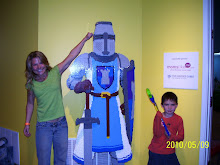This write-up is a review of an article that appeared on the Ithaca College Website today about Robin Sidman, an Ithaca College Alum, and her quest to create environmental awareness and change in schools and homes on a community level. Robin’s story is important because it demonstrates the power of one person to facilitate large-scale awareness and change for our children and our communities.
Through her efforts, many educational institutions have now established Greenschools, a program directed toward environmental wellness through education, awareness, and action.
******************************************************
In June of 2002, Boston, MA resident Robin Sidman and her family began to get sick, but instead of a normal cold or virus that runs it’s course and moves on, Robin, her husband, and her two young daughters seemed to be constantly ill from seemingly mysterious causes.
Baffled and frustrated, Robin schlepped her brood from doctor to doctor in hopes to discover both cause and cure. After exhaustive poking and prodding that involved everything from skin scratch allergy tests to comprehensive blood analysis, Robin and her family eventually found the culprit: their indoor and outdoor environment, including dust, mold, pets, household chemicals, and the air in their house. They were not even safe in their own beds. Since moving into a plastic bubble was hardly a viable option, Robin took alternative action.
Like most mothers, Robin addressed her children first, and she soon discovered a major culprit, her children’s school, since it was where her kid’s children spent most of their time. Robin researched possible culprits: indoor air quality, drinking water, school-provided lunches, exercise facilities, and two biggies- cleaning items and waste disposal. As mandated by the state to be “healthy”, most schools use heavy-duty cleaning agents created to eradicate the millions of germs and other ickyness that children are exposed to on a daily basis. These agents are invisible, and while most reasonably intelligent children would probably stay clear of a seething pool of evil-looking cleaning fluid, they generally do not give thought to the slight residual scent of harsh chemical cleansers on desks, pencil sharpeners, bathroom sinks, and school cafeterias tables. Used by hundreds of kids of all ages on a daily basis, surfaces retain these agents that cling to on hands that eventually travel to mouths, noses, skin, ears, and clothing. Combine that with a child who has asthma or a compromised immune system, and the well-intentioned actions of our public schools to keep children safe can actually make some children very, very sick.
So, what’s a mother to do? Robin, acted, and started Greenschools, a program designed to create personal health through environmental health. Using an integrative approach, Robin examined all of the aspects that impact both children and adults in public schools; indoor air quality, cleaning, eliminating waste, and drinking water. Next, she advocated combining recycling and proper waste disposal with environmental health by providing services such as staff and student education on healthier cleaning products, waste-free lunches, PTA topics about creating and maintaining healthy homes.
Robin maintains that the Greenschools program is a culmination of education, seeking cures for sickness, and parenting of two young children who suffer with chronic illness. And, it would seem that her efforts are successful. Any parent with a sick child understands the domino effect of a sick day. No child care center will take a sick child, and a child generally has to be enrolled in such a program anyway. Relatives might possibly offer support, but family is not always close by or able to help. Stay-at-home Mamas who love to have regular play dates will not care for a sick young one as they understandably want to protect their own kids from exposure. Most schools have policies that any child with a temperature over 100 must stay at home for at least 24 hours until the fever subsides, and combined with a lack of care, that usually means a “sick” day for the parent as well. And while FMLA protects employees who have at least one year of service and at least 1250 hours within that year (roughly 33 hours per week of uninterrupted service), other parents don’t enjoy that protection and may find them out of a job if they have a chronically sick child at home. Recognizing this web of predicaments, Robin took her Greenschools program beyond the local, and more programs are currently in the process of establishing similar initiatives that are addressing environmental issues and education for both school and home.
